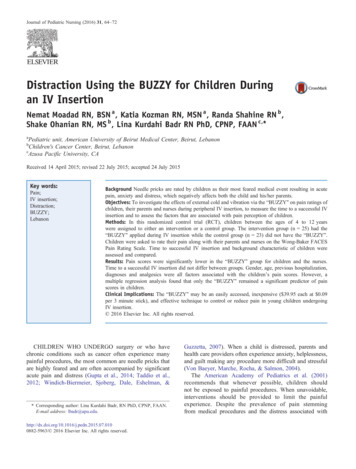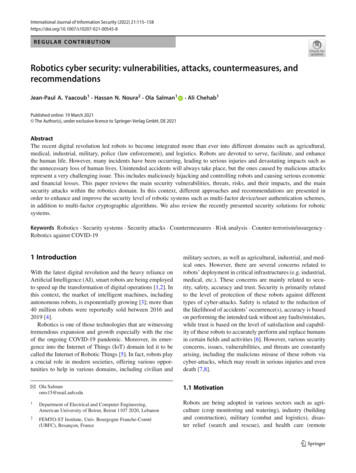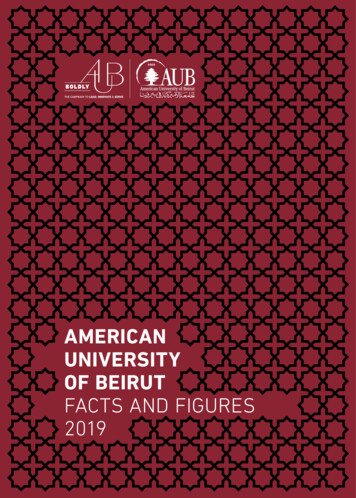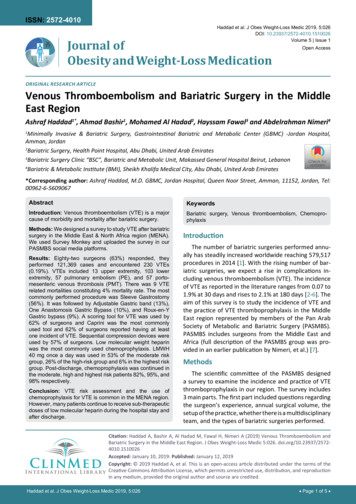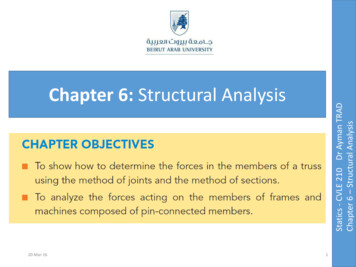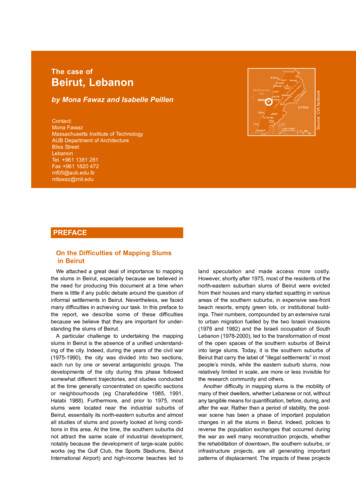
Transcription
The case ofby Mona Fawaz and Isabelle PeillenContact:Mona FawazMassachusetts Institute of TechnologyAUB Department of ArchitectureBliss StreetLebanonTel. 961 1381 281Fax 961 1820 472mf05@aub.edu.lbmfawaz@mit.eduSource: CIA factbookBeirut, LebanonPREFACEOn the Difficulties of Mapping Slumsin BeirutWe attached a great deal of importance to mappingthe slums in Beirut, especially because we believed inthe need for producing this document at a time whenthere is little if any public debate around the question ofinformal settlements in Beirut. Nevertheless, we facedmany difficulties in achieving our task. In this preface tothe report, we describe some of these difficultiesbecause we believe that they are important for understanding the slums of Beirut.A particular challenge to undertaking the mappingslums in Beirut is the absence of a unified understanding of the city. Indeed, during the years of the civil war(1975-1990), the city was divided into two sections,each run by one or several antagonistic groups. Thedevelopments of the city during this phase followedsomewhat different trajectories, and studies conductedat the time generally concentrated on specific sectionsor neighbourhoods (eg Charafeddine 1985, 1991,Halabi 1988). Furthermore, and prior to 1975, mostslums were located near the industrial suburbs ofBeirut, essentially its north-eastern suburbs and almostall studies of slums and poverty looked at living conditions in this area. At the time, the southern suburbs didnot attract the same scale of industrial development,notably because the development of large-scale publicworks (eg the Gulf Club, the Sports Stadiums, BeirutInternational Airport) and high-income beaches led toland speculation and made access more costly.However, shortly after 1975, most of the residents of thenorth-eastern suburban slums of Beirut were evictedfrom their houses and many started squatting in variousareas of the southern suburbs, in expensive sea-frontbeach resorts, empty green lots, or institutional buildings. Their numbers, compounded by an extensive ruralto urban migration fuelled by the two Israeli invasions(1978 and 1982) and the Israeli occupation of SouthLebanon (1978-2000), led to the transformation of mostof the open spaces of the southern suburbs of Beirutinto large slums. Today, it is the southern suburbs ofBeirut that carry the label of “illegal settlements” in mostpeople’s minds, while the eastern suburb slums, nowrelatively limited in scale, are more or less invisible forthe research community and others.Another difficulty in mapping slums is the mobility ofmany of their dwellers, whether Lebanese or not, withoutany tangible means for quantification, before, during, andafter the war. Rather than a period of stability, the postwar scene has been a phase of important populationchanges in all the slums in Beirut. Indeed, policies toreverse the population exchanges that occurred duringthe war as well many reconstruction projects, whetherthe rehabilitation of downtown, the southern suburbs, orinfrastructure projects, are all generating importantpatterns of displacement. The impacts of these projects
Urban Slums Reports: The case of Beirut, Lebanonare either in displacements to make way for developments, or in attracting labour to work for the projects.Quantifications are available for important moments ofthe war, such as the estimated 200,000 individuals whonavigated from the eastern to the southern suburbs ofBeirut between 1975 and 1976, or the 700,000 to900,000 displaced at least once over the 15 years of thewar (Virely 2000). Prior to the war, reports on slums alsooften mention Arab workers (especially Syrian), and thetransformation of some of the slums over time withchanges in their dwellers, especially Qarantina.Finally, a major hindrance to the mapping of slums isthe scarcity of information on the topic, especially oncurrent conditions. We often had to rely on limited fieldwork and interviews with public officials conductedpersonally for our information. Despite the difficultiesfaced in creating a reliable typology, the analysis wepropose below attempts a first unified understanding ofthe slums of Beirut that we think is useful for initiating adiscussion of the slums in the city.IINTRODUCTION: THE CITYA.THE URBAN CONTEXT1. National OverviewLebanon is a small country of 10,425 km2 in SouthWest Asia. The country has a 200km coastline, runningnorth-east - south-west along the eastern shores of theMediterranean Sea. It borders with Syria and Israel. Thetotal population is estimated at around 4 million1, 86.6per cent of whom live in cities, with 32.5 per cent or 1.3million people living in Beirut and its suburbs alone (ACS1998).The country’s modern history is marked by religiousand political strife, which led to a succession of conflicts(1860, 1958) and culminated in the 1975-1991 civil war.The country was also particularly marked by its regionalcontext, with the trans-Arab national movements of the1960s as well as the Arab-Israeli conflict since 1948Evolution of Slums in Beirut: Far-Eastern suburbs2
U N D E R S TA N D I N G S L U M S : C a s e St u d i e s f o r t h e G l o b a l R e p o r t o n H u m a n S e t t l e m e n t s 2 0 0 3(Corm 1986). Lebanon particularly suffered from theArab-Israeli war. Between 1978 and 2000, sections ofthe country were occupied by Israel, including the capital city in the summer of 1982. Military conflicts wereparticularly destructive, with important human andmaterial casualties: some 65,000 dead, 84,000wounded, 22 per cent of Lebanese families displaced atleast once, and 700,000 to 900,000 émigrés, as well asthe destruction of the physical infrastructure of thecountry (water, electricity, telephone networks, roads),some 300,000 houses severely damaged, and mostproductive sectors negatively affected. The war and itsvarious consequences (including severe inflation) arealso recognised as having substantially impoverishedLebanese households, reduced the country’s middleclass, and exacerbating already existing income differences. By the end of the war, the Lebanese GDP haddecreased by two thirds (Baz 1998, Haddad 1996).The Independence Years (1942-1975)Until 1918, Lebanon was part of the Ottoman Empire.The country gained its independence in 1942, aftertwenty years under the rule of the French Mandate,during which many of the current institutional set-upswere created. The post-independence phase was alsomarked by rapid demographic growth and continuousrural-urban migration (Bourgey 1985).Until the beginning of the 1970s, the country’s policies were marked by a strong economic and a relativelypolitical liberalism. At the time, the Lebanese economyboomed, mainly from an influx of capital from neighbouring countries (oil, rent and others) as well as fromLebanese expatriates, all attracted by the guaranteedsecrecy of the Lebanese banking system. Capital wasessentially invested in real estate and construction, andcontributed to the growth of the capital city (Tabet2001). By 1975, the Lebanese economy essentiallyrelied on its service sector, at the expense of the industrial, and especially the agricultural sectors. Few if anysocial policies were developed, and with the exceptionof some emergency measures, the state intervenedrarely to improve housing conditions.Evolution of Slums in Beirut: East and Near-Eastern suburbsSome exceptions to these tendencies can be seenunder the mandate of President Chehab (1958-1964),who was elected after the short civil conflict of 1958,and sought to strengthen the presence of the statethrough regional development policies, the establishment of social institutions, and the control of the growthof Beirut. To this end a number of public institutionswere created and the first five-year development planwas launched (Fawaz 2002, Tabet 2001). These effortsdid not however reduce the drastic level of incomeinequality in Lebanese society and the resultingmassive rural-urban migration.The War Years (1975-1990)During the fifteen years of the civil war social,economic, physical, political, and administrative structures were almost completely destroyed. The centralstate also lost much of its power and its services wereconsiderably reduced. Furthermore, much of the country’s productive apparatus was considerably weakenedand the informal and illegal (war) economy flourishedconsiderably. The country has also faced, as of 1982, arampant inflation that has impoverished its middleclasses.Post War Reconstruction (1990-Present)The post war reconstruction phase has been markedby two national plans: the National EmergencyReconstruction Plan (NERP), orchestrated for the firstfive years of reconstruction and Plan Horizon 2000,complemented later by Plan Horizon 2005. The twoplans are managed by the Council for Development andReconstruction (CDR), created in 1977 as a publiccentral management organism for all reconstructionworks. A total of 130 projects were planned, over 15sectors. The plans are essentially financed by foreignand internal loans (CDR 1992).Most investments are concentrated in physical infrastructure and large-scale “showcase” projects. Publictransit, low-income housing, and other salient socialproblems are not addressed. In order to solve the problem of displacement, the Ministry of Displaced People
Urban Slums Reports: The case of Beirut, Lebanonwas instituted, and a ‘return programme’ was launched.Between 1993 and 1995, substantial economic growthwas noted in the country. However, since 1996, theeconomic activity in the country has shown a substantialslow-down, especially because of the current crisis in thereal estate and construction sectors and the unstableregional context, including large-scale Israeli bombardments in 1993 and 1996 (Aveline 2000). The budgetdeficit has now reached alarming levels - 38 per cent in1999. Furthermore, the volume of debts, both internaland external, has substantially increased because thecountry is unable to service its debts, which havereached over US 30 billion (UN-ESCWA 2000). Sincethe end of the war, several studies have pointed toincreases in poverty levels and worsening of living condition indicators: over 25 per cent of the population livesbelow the poverty line (Haddad 1996), and medianincomes have been reduced considerably, according toone study, by 50-60 per cent in comparison to what theywere in 1966. Currently, 25.8 per cent of individuals livingin Beirut earn less then US 106/month, and the rate ofcredit is five times higher than in 1966 (Hamdan 2001).2. The History of BeirutUntil 1840, Beirut was a secondary port city of theOttoman Empire, with a total of 5,000 inhabitants. Thecity began to grow exponentially during the phase thatpreceded the French Mandate, and already had130,000 inhabitants by 1915. By that time Beirut hadbecome an important port city and a major point ofpassage between the Syrian hinterland and Europe.Important infrastructure works at the time, such as theBeirut-Damascus road (1863), the railway to Houran,and the extension of the port (1895) all attest to thisnewly gained importance (Beyhum 1991).The French Mandate continued with the modernisingpolicies already begun by the Ottomans (known asTanzeemat). In 1920, Beirut became the capital city ofGreater Lebanon, headquarters of the central administration of the Levant States by the French Mandate, andconfirmed its future political and economic roles.Planning for the central city district destroyed much ofthe old city and paved the way for new road developments. Around this node, the city grew along three mainaxes: the Damascus Road (east), Tripoli Road (north)and Saida Road (south). The city also integrated newhousing quarters, such as the Armenian quarters (eastern suburbs) (Beyhum 1991, Tabet 2001).The post-independence phase (1944-1958) of Beirutwas characterised by rapid demographic growth andspectacular spatial development. The city benefitedfrom local industry developed during the preceding era.Until 1975, both capital and the educated elite arrivedfrom nearby countries to the capital city, and Beirutbenefited from a highly efficient banking sector. Beirutalso housed waves of low-income refugees andmigrants coming from its own hinterlands (SouthLebanon, Beka’a, and the north), as well as migrantworkers and waves of Palestinian refugees displaced in1948 by the creation of the state of Israel. By 1960, thepopulation of the Beirut agglomeration was estimated at400,000 inhabitants (Mission IRFED 1963). The citywithin its municipal boundaries became denser and newneighbourhoods were created. Villages surroundingBeirut were incorporated as extensions of the city, lowincome suburbs extended beyond the Armenian quarterand onto agricultural lands to the south (Beyhum 1991).4
U N D E R S TA N D I N G S L U M S : C a s e St u d i e s f o r t h e G l o b a l R e p o r t o n H u m a n S e t t l e m e n t s 2 0 0 3Attempts at planning the development of Beirut and itsextensions were unable to limit real estate speculationor balance political and economic forces in favour of thecity. In consequence, rural migration, refugees from thesouth and from Palestine, as well as migrant workersfrom neighbouring countries all fuelled the city’s “miserybelt”, which gained visibility from the 1960s (DGU 1973,Tabet 2001). These neighbourhoods with poor livingconditions housed the successive waves of ruralmigrants as well as foreign refugees and workers whosenumbers were estimated at some 60,000 persons at thebeginning of the 1975 civil war. The majority of themwere non-Lebanese. In fact, estimates at the timeconsidered that one quarter of the population residing inLebanon was non-Lebanese and that two thirds of theseforeigners were Palestinians (Bourgey and Pharès1973). These population movements generated a newurban geography for Beirut as well as its suburbs, whichgrew denser. Within the urban agglomerations, densityhad also increased and problems of congestionappeared (DGU 1973, Tabet 2001).Both Beirut and its suburbs were severely damagedby the war, with an estimated 10 per cent of constructions destroyed. The city was divided into two sections,one predominantly Christian, the other predominantlyMuslim, run by rival militias, and the old core wascompletely emptied, then squatted in by refugeescoming from various parts of the country. Depending ontheir religion, entire populations were evicted form thewestern and eastern sections of the city and theymoved in waves out of their areas of origin towardsareas where they would be safer. The large urbanperiphery provided new spaces for urbanisation fordisplaced populations and urbanisation increasedcontinuously, along the entire coast and on thesurrounding hills (Beyhum 2001, Tabet 2001). Much ofthe growth of the city at the time occurred illegally, inviolation of building codes, construction codes, andproperty rights regulations.Reconstruction of Beirut and its suburbs began in1991, essentially under private initiatives, with theconstruction of new buildings (around 15,000) and theeviction of squatters in many areas, including the citycore and the old green line. The state has also launchedlarge-scale infrastructure projects (roads, services, etc)and facilities (eg sport stadiums, the extension of theairport and the port, governmental hospitals, theLebanese university campus, etc). Many of these projects led to the displacement of hundreds of families(whether squatters or not), highways intersected denseneighbourhoods of the city, and important disruptions inthe urban fabrics ensued (see section IV).The state has also organised several large-scaleurban projects, the most important of which was thereconstruction of Beirut downtown, which has beenentrusted to a private company, Solidère, under thedirect guidance of Prime Minister Hariri, a major shareholder in the operation.2 Other projects include the rehabilitation of the North Coast (Linord), which has organised hundreds of hectares of reclaimed land over thesea, as well as the Elyssar Project, designed to rehabilitate the southern suburbs of the city, displace squattersfrom the coast and build several thousand housing units(described below, section IV). Since 1995, investmentshave slowed down, and the execution of large-scaleprojects and highways has either halted or continues ata slower pace.3. The Physical CityMunicipal Beirut is at the geographical centre of theLebanese coast, in the form of a cape extending over 9kminto the sea. The city is built on an undulating site that fallssharply to the north-west, west and east and more gentlyto the north where the port and the old city core arelocated. There are three elevated areas within the municipal boundaries, Moussaitbeh, Kraytem, and Achrafieh(the highest, at 95m above sea level), in which mostdevelopment occurred in the first phase of urbanisation(late 19th century) (Ministry of Planning 1968). Since then,the city has gradually extended onto its southern sandy(west) and agricultural (east) plains, northern coastalplains, and the nearby mountainous areas.The city enjoys a Mediterranean climate with mildwinters and hot, humid summers. The spring andautumn are agreeable. Rainfall is seasonal and fallsmainly during the winter. Prevailing breezes are southwesterly, which is typical of this coastal area (Ministry ofPlanning 1968).4. DemographicsWata El Moussaitbeh5Between 1950 and 1970, Beirut witnessed a largescale expansion that multiplied its population by four,climbing from 300,000 to 1,100,000 inhabitants. By1975, Beirut already housed one quarter of the
Urban Slums Reports: The case of Beirut, LebanonLebanese population (Bourgey 1985). The waves offoreign migrant workers, especially Syrian, as well asPalestinian refugees (many of whom left their camps inrural areas for those in Beirut) constituted a considerable section of these residents, around 45 per centaccording to some estimates (Bourgey 1985).Today, the metropolitan region of Beirut has1,340,000 inhabitants, that is, one third of the totalpopulation residing within Lebanon (excluding seasonalworkers). As for municipal Beirut, it now houses 403,337persons, who constitute only 10 per cent of the totalpopulation of the country, a notable decrease from the22.3 per cent it constituted in 1970 (Hamdan 2001).The reduction in the birth rate, already begun in the1970s, continues, generating a relative ageing of thesociety. This phenomenon is particularly noticeable inBeirut, where only 34 per cent of the population is agedbelow 20 years, compared to 50 per cent in 1970 (ACS1972, 1998). Other indictors also highlight differencesbetween the Metropolitan Region of Beirut and the restof the country, such as relatively better schools, higherliteracy rates (only 8.7 per cent of Beirut residents areilliterate, while 11.6 per cent of the total residents ofLebanon are), better health care services, and highermedian incomes (ACS 1998).Over the last decade, women seem to have accessedcollege education in equal numbers to men (ACS 1998).They nonetheless still constitute the largest section of theilliterate population (12 per cent of women compared to 5per cent of men), especially among women over 25.Women’s economic activity is also much lower thenmen’s (76.4 per cent and 30.7 per cent), especially withinthe suburbs. Women’s median salaries are also clearlylower then men’s in all categories of employment (424US /month versus 557 US / month).5. The Urban EconomyBeirut’s rapid growth over the last century is tied to itseconomic role as a location of transit for goods, notablyto Damascus, and its port, which plays a vital role in itseconomic life (Fawaz 1964, Mission IRFED 1963).During this era, the urban economy was also heavilycentred on commerce, particularly the vibrant gold andmoney market (Mission IRFED 1963). The Lebaneseeconomy is largely marked by its service sector, whichhas been the largest employer before, during, and afterthe war. (Around 55 per cent of the total active population in Lebanon already worked in the tertiary sector inthe 1970s) (ACS 1972). From the end of the militaryconflict the banking sector has begun to re-emerge andtoday plays an important role in the economy of thecountry (Hamdan 2001). It is important to mention thesize of the informal economy, which most economistsagree holds a dominant place in the country, especiallysince 1975.As for urban industries, they grew considerably in thepre-war era and the number of Lebanese workers in thissector almost quadrupled, from 35,000 in 1953 to150,000 persons in 1975, that is 19 per cent of theLebanese work force, a percentage considerably higherthan in neighbouring countries (eg double the figure inSyria). Almost half of this sector (43 per cent) waslocated in Beirut (Mission IRFED 1963). In 1974, around40 per cent of the workforce living in the Beirut suburbswas employed in the industrial sector, and in 1980, mostof these workers, that is around 60 per cent of the industrial workforce, was concentrated within the Lebanesecapital (Nasr 1974, 1982).Looking at the work force, around 38 per cent of theresidents of Beirut are currently working, a rate slightlyhigher then the country’s average. This differencereflects the higher rate of involvement of women in theeconomy (22 per cent in Beirut, 14.7 per cent inLebanon). Unemployment rates are also slightly lowerin the capital city. The minimum wage is US 190/month.6. GovernancePolitical StructuresThe Lebanese political system was established underthe French Mandate rule (1920-1942) and many of theexisting institutional structures (especially the bureaucratic and the judicial systems) were organised at thetime and followed the French model. The first republicwas declared in 1926, with the first constitution.The country has a republican form of government withan executive body (the president, elected by the 128members of parliament and the government), a legislative body (the parliament, elected by all Lebanese aged21 and above), and a judicial body.The constitution was revised in 1989, during the TaefAgreements that marked the end of the 1975-1990 civilwar. Among the major changes instituted by the newconstitution is the redistribution of power, initially concentrated in the hands of the president, to the council ofministers whose membership was distributed across religious groups. One unusual characteristic of theLebanese political system is the establishment of a quotasystem that dictates the political representation of variousreligious groups and the religious affiliation of importantruling members (eg the President has to be ChristianMaronite, the prime minister Muslim-Sunni, etc).Administrative StructuresThe structure of the Lebanese administration is rathercentralised. The country consists, from an administrative point, of 6 governates called mohafazats, administered by an appointed high level public sector servant,the muhafez. Each of these is subdivided into a total of26 quarters, called qada’a, each headed by anappointed caim-maqam. The municipality is the locallyelected representative body. All municipalities have anelected municipal council headed by an elected mayor(except Beirut whose mayor is appointed).6
U N D E R S TA N D I N G S L U M S : C a s e St u d i e s f o r t h e G l o b a l R e p o r t o n H u m a n S e t t l e m e n t s 2 0 0 3II. SLUMS AND POVERTYB.TYPES OF SLUMS IN BEIRUTTowards a Definition of Slums in BeirutGiven its complex history, the limited illegalities inproperty rights, and the widespread violation of buildingand construction codes, it is difficult to adopt legality asa criterion for slum identification in Beirut.3 We havetherefore adopted, for the purpose of this study, a definition that identifies slums as areas of the city where themajority of residents live in precarious economic and/orpolitical conditions, with high levels of vulnerability, andwhere services and living conditions appear to be lowerthen other sections of the city. Also, given the absenceof public data on these areas, and/or on poverty in thecity, our definition and assessments rely essentially onqualitative measures, developed through our ownresearch experiences in the city, various reports(academic and professional) in Lebanon and Beirut, aswell as interviews with slum dwellers, researchers, andpolicy makers. Hence, we do not claim to present in thistypology, a comprehensive listing of slums and theirliving conditions in the Metropolitan Area of Beirut butrather an initial investigation, designed to bring visibilityand attention to those areas in the city, and to proposetheories that can explain their location and the logic oftheir evolution.traces remain of the Armenian camps while thePalestinian camps are among the main slums of the city. Slums that began as housing areas for ruralurban migrants (1950s-1960s)These slums housed the various waves of rural tourban migrants arriving in Beirut and its suburbs in relation to the country’s industrialization and urbanizationprocesses, coming especially from South Lebanon andthe Beka’a Valley where poverty and insecurity (in thecase of the South) gradually encouraged an importantmigratory movement. We also include in this sectionone exceptional camp that grew, at least in part, tohouse Syrian rural migrants (Wata Mousaytbeh).Several types of slums should be listed under thiscategory, according to their location, and the conditionsof their development: (i) slums that developed either asa direct extension of existing refugee camps, or in theirclose vicinity; (ii) slums that developed on agricultural orgreen land, in the far suburbs of the capital city, and inviolation of urban regulations, and (iii) slums that developed as squatter settlements in areas of contestedproperty rights, often in the context of political rivalriesamong elite groups. In general these human settlements conform to various schemes of illegal land occupation/illegal land subdivision described elsewhere inthe Third World.1. Typology of SlumsThe analysis we propose below attempts a unifiedunderstanding of the slums of Beirut and proposes atypology that organises them according to their mode ofproduction and the particular regional and national political situations that led to their establishment.Furthermore, depending on the time when they developed, and the region where they were located, each ofthese types, as is explained below, tends to have somecommon characteristics, in terms of location, relation tothe law, level of services, and living conditions. In somecases, and given a long and complex history, slums canbelong to several categories and we have includedthem in both. Following this approach, the followingcategories of slums can be listed: Slums that began as internationalrefugee campsor low-income housing areas for internationalrefugees (instituted from 1920-1955)Refugee camps are historically the oldest slums ofBeirut. These slums are located within and outside thecity’s municipal boundaries. Camps were organised forArmenian (1920s), Syriac (1920s) and Palestinian(1948) refugees with the help of international organisations, while Kurds occupied abandoned camps anddeteriorating tenements in the city centre. Today, only7Wata Mousaytbeh
Urban Slums Reports: The case of Beirut, LebanonA typology by historical origins shouldhowever not lead to the conclusion thatslums today differ greatly because oftheir origin. On the contrary, manycontemporary forces that act on theseslums have resulted in similar patterns ofevolution. Slums that began as squatter settlements during the period of the civilwar (1975-1990)These areas grew in several parts ofthe city, where refugees displaced by theearly events of the Lebanese civil war(1975) occupied either buildings or entireneighbourhoods, abandoned by theirowners (for reasons of security) or occupied large plots of land and transformedthem into large squatter settlements.OuzaiFor instance, all slums have witnessedthe development of large-scale rentalmarkets and renting has become, since 1982, theprimary method of accessing housing and a majorsource of income for old property owners in slums. Thisis further enhanced by the freezing of much of the housing stock by rent control outside slums and hence thereduction of rental opportunities for many low-incomepeople to such informal arrangements in slum areas.There are unfortunately no figures to list for the size ofthis market, but its development marks an importantchange in forms of occupation, their duration, as well asthe demographic structures of these areas that haveconsiderably increased in density.Similar demographic changes are also noted in allslums, especially since the 1990s, with the arrival of agrowing number of non-Lebanese workers (notablySyrian male workers), who live in these areas of thecity.4 Today, almost none of the slums could bedescribed as housing a group or community of similarnational or religious origins. On the contrary, each of theexisting slums has attracted migrants who arrived to thecity during its various phases of growth. Hence, earlyLebanese rural migrants tended to occupy areas withinor at the fringes of refugee camps.Furthermore, the populations displaced by variousmilitary conflicts and those coming from rural areas areconfused, and often individuals have several reasons fortheir displacement. Moreover, during the civil war amajor reshuffling of the populations occurred, someslums were emptied, partially or completely destroyedby militias, and today, almost all the slums of the cityhouse heterogeneous populations that include membersof all the migrant and displaced groups, as well as othermigrant labourers and low-income families from Beirut.Other similarities across slums can be perceived inthe methods of construction and the permanence of thebuilt structures. All slums combine a varying percentageof precarious, tin sheet and wooden houses with moresolid and permanent structures. All slums also contai
West Asia. The country has a 200km coastline, running north-east - south-west along the eastern shores of the Mediterranean Sea. It borders with Syria and Israel. The total population is estimated at around 4 million1, 86.6 per cent of whom live in cities, with 32.5 per cent or 1.3 million people living in Beirut and its suburbs alone (ACS 1998).
